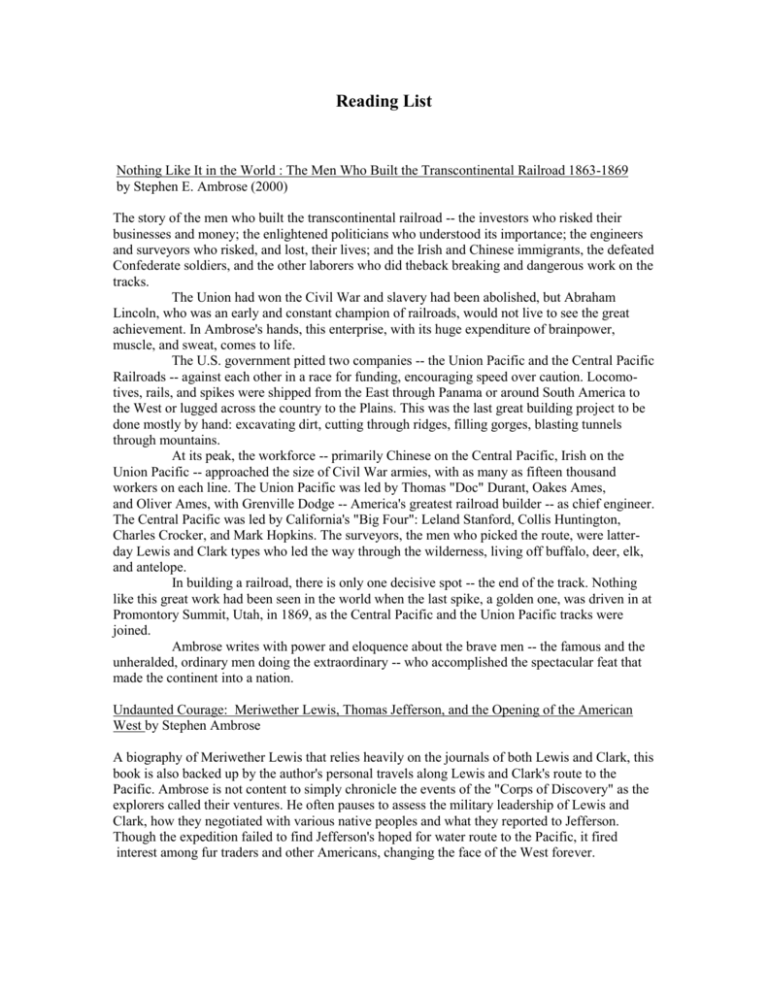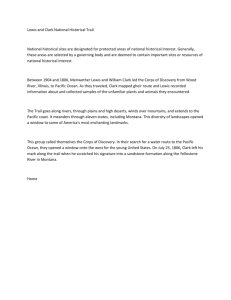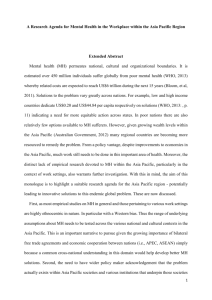
Reading List
Nothing Like It in the World : The Men Who Built the Transcontinental Railroad 1863-1869
by Stephen E. Ambrose (2000)
The story of the men who built the transcontinental railroad -- the investors who risked their
businesses and money; the enlightened politicians who understood its importance; the engineers
and surveyors who risked, and lost, their lives; and the Irish and Chinese immigrants, the defeated
Confederate soldiers, and the other laborers who did theback breaking and dangerous work on the
tracks.
The Union had won the Civil War and slavery had been abolished, but Abraham
Lincoln, who was an early and constant champion of railroads, would not live to see the great
achievement. In Ambrose's hands, this enterprise, with its huge expenditure of brainpower,
muscle, and sweat, comes to life.
The U.S. government pitted two companies -- the Union Pacific and the Central Pacific
Railroads -- against each other in a race for funding, encouraging speed over caution. Locomotives, rails, and spikes were shipped from the East through Panama or around South America to
the West or lugged across the country to the Plains. This was the last great building project to be
done mostly by hand: excavating dirt, cutting through ridges, filling gorges, blasting tunnels
through mountains.
At its peak, the workforce -- primarily Chinese on the Central Pacific, Irish on the
Union Pacific -- approached the size of Civil War armies, with as many as fifteen thousand
workers on each line. The Union Pacific was led by Thomas "Doc" Durant, Oakes Ames,
and Oliver Ames, with Grenville Dodge -- America's greatest railroad builder -- as chief engineer.
The Central Pacific was led by California's "Big Four": Leland Stanford, Collis Huntington,
Charles Crocker, and Mark Hopkins. The surveyors, the men who picked the route, were latterday Lewis and Clark types who led the way through the wilderness, living off buffalo, deer, elk,
and antelope.
In building a railroad, there is only one decisive spot -- the end of the track. Nothing
like this great work had been seen in the world when the last spike, a golden one, was driven in at
Promontory Summit, Utah, in 1869, as the Central Pacific and the Union Pacific tracks were
joined.
Ambrose writes with power and eloquence about the brave men -- the famous and the
unheralded, ordinary men doing the extraordinary -- who accomplished the spectacular feat that
made the continent into a nation.
Undaunted Courage: Meriwether Lewis, Thomas Jefferson, and the Opening of the American
West by Stephen Ambrose
A biography of Meriwether Lewis that relies heavily on the journals of both Lewis and Clark, this
book is also backed up by the author's personal travels along Lewis and Clark's route to the
Pacific. Ambrose is not content to simply chronicle the events of the "Corps of Discovery" as the
explorers called their ventures. He often pauses to assess the military leadership of Lewis and
Clark, how they negotiated with various native peoples and what they reported to Jefferson.
Though the expedition failed to find Jefferson's hoped for water route to the Pacific, it fired
interest among fur traders and other Americans, changing the face of the West forever.
Cats Paws and Catapults: Mechanical Worlds of Nature and People
By Steven Vogel (1998)
Nature and humans build their devices with the same earthly materials and use them in the same
air and water, pulled by the same gravity. Why, then, do their designs diverge so sharply?
Humans, for instance, love right angles, while nature's angles are rarely right and usually
rounded. Our technology goes around on wheels--and on rotating pulleys, gears, shafts, and
cams--yet in nature only the tiny propellers of bacteria spin as true wheels. Our hinges turn
because hard parts slide around each other, whereas nature's hinges (a rabbit's ear, for example)
more often swing by bending flexible materials.
In this marvelously surprising, witty book, Steven Vogel compares these two mechanical
worlds, introduces the reader to his field of biomechanics, and explains how the nexus of physical
law, size, and convenience of construction determine the designs of both people and nature.
Iron Bridge
By David Morse (1998)
From Kirkus Reviews , May 15, 1998
By the year 2047, following ecological collapse and the Petroleum Wars, vast areas of the globe
are radioactive, governments have splintered into corporate fiefdoms, and mutating viruses are
mopping up the few survivors. The commune of Ecosophia, in the American desert, is also dying,
but maybe, using a revolutionary mental technique, one person can travel back into the past
and change things. So, in the year 1773, Maggie Foster arrives naked in the middle of an
earthquake at Coalbrookdale in the English Midlands. Here, the world's first iron bridge will be
built, accelerating the Industrial Revolution and the devastation that will follow. But what if,
thought the Ecosophians, instead of standing for centuries, the bridge collapsed shortly after
completion?
Might this change the thrust and direction of the future? First, Maggie must worm her
way into the community of 1773 by finding a job in the household of ironmaster Abraham Darby
III, whose ambition is to build the very bridge that Maggie hopes to destroy. Abraham, a Quaker,
refuses to allow his iron to be made into cannons, unlike his ambitious and unscrupulous neighbor
and rival ironmaster John Wilkinson. But as Maggie becomes more and more integrated into the
lives of the Darby family and the other people around her, the less sure she is that the
Ecosophians' chosen course of action will be effective. Time travel and its consequences are the
least satisfactory aspects of this first novel, an otherwise richly evocative and fascinating piece of
historical speculation. -- Copyright ©1998, Kirkus Associates, LP. All rights reserved.
Skunk Works
By Ben Rich (1994)
An insider's story of Lockheed's Skunk Works, the supersecret facility that developed the U-2
American spy plane and other high-technology aircraft, follows the period of the author's career
from 1975 to 1990.
When Things Start to Think
By Neil Gershenfeld (1999)
An astonishing look at the cutting edge where digital intelligence is woven into everything we
touch.
Neil Gershenfeld finds computers on desks painfully passe. And he is miles ahead of anybody
else in freeing the good stuff of digital technology--the electronic "bits"--from the clunky boxes-the "atoms"--that now constrain them. How about a traditional book, printed on paper and
pleasant to read in bed, but with the mutability of a screen display? Pop in one microchip and
your book is Sue Grafton. Pop in another, the electronic ink reconfigures, and it's Thomas
Pynchon. This is the kind of technology Gershenfeld has up and running in his lab today, along
with the means for electronic cash, musical keyboards woven into blue-jean jackets, the "Personal
Fabricator" that can organize digitized atoms into anything you want, and an electronic cello he
developed with Yo Yo Ma. As Gershenfeld describes his work, he offers profound insights into
the world of computation vis-a-vis the structure of matter, offering the prospect of quantum
computers and liquid chips, as well as a whole new model of both education and research based
on his Things That Think consortium. (Publisher’s description)
The Return
Buzz Aldrin, John Barnes (2000)
On July 20, 1969, Buzz Aldrin, along with crewmate Neil Armstrong, made history as they
placed humankind's first steps on the moon.
Now, in The Return, written by award winning novelist John Barnes, Aldrin offers a compelling
novel about the opportunities and dangers that confront us today-and shows why we must, and
will, seize the challenges before us.
When a tragic Shuttle accident kills a world-famous basketball player on his trip into space, a trip
that had been planned as a PR coup for the space program, former astronaut Scott Blackstone is
out of a job. Worse, he and his "Citizen Observer" program are vilified in the media, and he's
being sued for a billion dollars. His older brother, Nick, research chief for a major aerospace firm,
persuades Scott's estranged ex-wife, Thalia-a top-ranked attorney-to take on Scott's defense.
Gradually, it begins to appear that the "accident" might not have been an accident at all.
Meanwhile, as long feared, India and Pakistan go to war-and, worse, Pakistan deploys a nuclear
device high in the upper atmosphere, putting the crew of the orbiting International Space Station
in imminent danger of destruction by radiation exposure.While the world's space vehicles are
grounded by the radiation storm set off by the detonation, only a few weeks remain to rescue the
crew, and there's no known way to do it. Save, perhaps, for a secret project of Nick's...
The Return is a story of outsized characters, global crises, and big, daring ideas...and-as told by
Buzz Aldrin-it carries a ring of truth. He's been there. He's done that. And he's already helped
change the world. (Publisher’s decrisption)
Airframe
Michael Crichton (1997)
On its way over the Pacific, a Chinese charter flight from Hong Kong to Denver "porpoises," or
steeply dives and climbs in rapid succession, for two minutes without warning. This "incident"
produces plenty of lost lunches--and 3 (eventually 4) deaths and 56 injuries. Norton Aircraft,
maker of the plane's airframe (i.e., fuselage, tail, and wing), has to find out what happened and
why pronto or lose a huge sale of the same model to China--and have to pink-slip all its
employees, sending ripples throughout the economy as subcontractors do likewise. Norton VP
Casey Singleton is point person for the investigation: she has to stay on top of the overall
inquiry and keep the top brass and the media apprised of progress. Making her job harder is the
chief operating officer, chafing over not being company president and friendly as a snapping
turtle, anyway; a pesky--and mysterious--new "assistant" ; labor unrest over rumors that Norton
will let the Chinese assemble the wings (the most labor-intensive part of plane building) as part of
the sale; and a careless-with-the-truth TV producer eager to expose a flying death trap. Loading
it with interesting detail on airliner construction, aerodynamics, the international trade in
commercial aircraft, and air safety, Crichton produces a taut, absorbing suspenser, anyway. (from
Booklist)
Off the Planet: Surviving Five Perilous Months Aboard the Space Station Mir
Jerry Linenger (1999)
Imagine yourself in a decaying space station far away from the atmosphere you never realized
you needed so badly, not knowing if the next malfunction would kill you or merely keep you
busy. Dr. Jerry M. Linenger experienced just this and describes his harrowing but ennobling five
months aboard Mir in Off the Planet, a memoir that evokes the excitement of living every day as
a life-threatening adventure. Linenger's very personal writing style draws the reader into the story
quickly, breezing through his childhood, Annapolis training, medical school, and selection as an
astronaut, then moving quickly to the Mir assignment and its aftermath.
Linenger isn't shy about sharing his opinions. Chapter titles like "Broken Trust" and "An
Attempted Coverup" show his feelings about the bizarre relationship between the crew and
mission control that may have kept him and his Russian comrades in constant danger. He also
heaps praise on his fellow crew members and family for their strength and perseverance
throughout the mission--between communication difficulties, the cloud of doubt surrounding the
station's systems, and problems like fires and toxic fumes, it's a wonder anyone survived with
their sanity intact. The full-color pictures accompanying the text add further insight into life
aboard Mir. (Amazon.com)
Killer Angels
Michael Shaara (1993)
This novel reveals more about the Battle of Gettysburg than any piece of learned nonfiction on
the same subject. Michael Shaara's account of the three most important days of the Civil War
features deft characterizations of all of the main actors, including Lee, Longstreet, Pickett,
Buford, and Hancock. The most inspiring figure in the book, however, is Col. Joshua Lawrence
Chamberlain, whose 20th Maine regiment of volunteers held the Union's left flank on the second
day of the battle. This unit's bravery at Little Round Top helped turned the tide of the war against
the rebels. There are also plenty of maps, which convey a complete sense of what happened July
1-3, 1863.
Black Hawk Down
Mark Bowden (2000)
Journalist Mark Bowden delivers a strikingly detailed account of the 1993 nightmare operation in
Mogadishu that left 18 American soldiers dead and many more wounded. This early foreignpolicy disaster for the Clinton administration led to the resignation of Secretary of Defense Les
Aspin and a total troop withdrawal from Somalia. Bowden does not spend much time considering
the context; instead he provides a moment-by-moment chronicle of what happened in the air and
on the ground. His gritty narrative tells of how Rangers and elite Delta Force troops embarked on
a mission to capture a pair of high-ranking deputies to warlord Mohamed Farrah Aidid only to
find themselves surrounded in a hostile African city. Their high-tech MH-60 Black Hawk
helicopters had been shot down and a number of other miscues left them trapped through the
night. Bowden describes Mogadishu as a place of Mad Max-like anarchy--implying strongly that
there was never any peace for the supposed peacekeepers to keep. He makes full use of the
defense bureaucracy's extensive paper trail--which includes official reports, investigations, and
even radio transcripts--to describe the combat with great accuracy, right down to the actual
dialogue. He supplements this with hundreds of his own interviews, turning Black Hawk Down
into a completely authentic nonfiction novel, a lively page-turner that will make readers feel like
they're standing beside the embattled troops. This will quickly be realized as a modern military
classic.
Sea Fighter
James H. Cobb (2000)
Commander Amanda Lee Garrett leads a United Nations naval force into a high-tech war-at-sea
in this new addition to a series hailed by Kirkus Reviews as "first-rate military suspense."
In Sea Fighter, Garrett heads a U.N. task force made up of units from Great Britain, France, and
the United States. Her mission: halt a rapidly escalating African civil war. A renegade Nigerian
general has invaded Sierra Leone and Guinea and is determined to establish a new "West African
Union" no matter the human cost. Garrett's only hope is an arsenal of untested weapons including
a flotilla of fast, heavily armed stealth hovercraft specifically designed for a deadly coastal
seawar and a gigantic ocean-borne fortress that can be anchored off an enemy's coast, literally at
the doorstep of their capital city.
Cobb, "a military buff par excellence" (Publishers Weekly), has crafted another riveting tale
featuring one of the most original characters in military fiction and the state-of-the-art technology
and strategy the U.S. Navy will almost certainly one day employ.
Sidewinder: Creative Missile Development at China Lake
Ron Westrum








